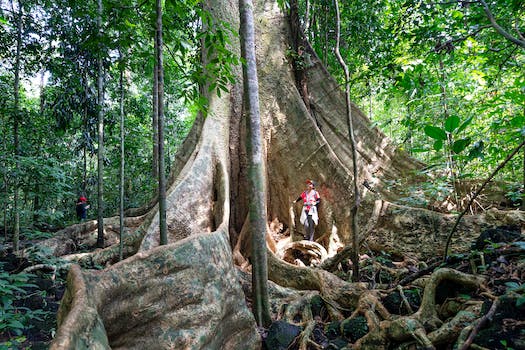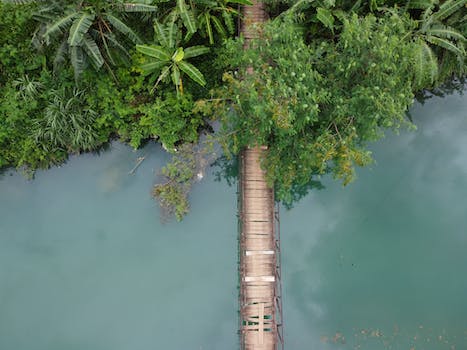Birdwatching in the jungle can be an exciting and rewarding experience, but it can also be challenging. With so many different species of birds and a dense forest environment, it can be difficult to spot and identify them all. In this article, we will provide you with 10 tips to help make your birdwatching experience in the jungle more enjoyable and successful.
- 1. Introduction
- 1.1. What is birdwatching?
- 1.2. Why birdwatching in the jungle?
- 1.3. Preparing for birdwatching in the jungle
- 1.4. What to bring
- 1.5. Safety precautions
- 2. Best Places for Birdwatching in the Jungle
- 2.1. Amazon Rainforest
- 2.2. Borneo Rainforest
- 2.3. Congo Basin
- 2.4. Sumatra Jungle
- 2.5. Pantanal Wetlands
- 3. Tips for Successful Birdwatching in the Jungle
1. Introduction
Birdwatching in the jungle can be an exciting and rewarding experience for nature enthusiasts. With over 1,000 species of birds found in the Amazon rainforest alone, there is no shortage of opportunities to spot some of the world’s most exotic feathered creatures. However, birdwatching in the jungle also presents its own set of challenges, from navigating dense foliage to avoiding dangerous wildlife. In this article, we’ll provide you with 10 tips to make the most out of your birdwatching adventure in the jungle.
1.1. What is birdwatching?
Birdwatching, also known as birding, is the activity of observing and studying birds in their natural habitat. This can be done for scientific research, as a hobby, or simply as a way to appreciate the beauty of nature. Birdwatchers use binoculars, spotting scopes, and field guides to help them identify different species of birds. Birdwatching can be done anywhere, from your own backyard to remote wilderness areas. It is a popular pastime around the world and can be enjoyed by people of all ages and skill levels.
1.2. Why birdwatching in the jungle?
Birdwatching in the jungle offers a unique and exciting opportunity to observe a diverse range of bird species in their natural habitat. The jungle is home to a vast array of birds, from colorful parrots and toucans to swift-flying hummingbirds and stealthy raptors. Exploring the jungle’s lush vegetation and listening to the sounds of the forest can be an unforgettable experience for birdwatchers of all levels. Whether you are a seasoned birder or a beginner, the jungle has something to offer. In this article, we will provide you with 10 tips for birdwatching in the jungle to help you make the most of your birding adventure.
1.3. Preparing for birdwatching in the jungle
When preparing for birdwatching in the jungle, it’s important to take into consideration the unique environment you will be in. The jungle can be hot, humid, and dense, making it challenging to spot and identify birds. However, with some careful planning and preparation, you can have a successful and enjoyable birdwatching experience in the jungle. In this article, we will provide you with 10 tips to help you prepare for birdwatching in the jungle.
1.4. What to bring
When venturing into the jungle for a day of birdwatching, it’s important to come prepared with the right gear and supplies. Not only will this make your experience more enjoyable, but it can also ensure your safety and comfort. Here are some essential items to bring along:
1.5. Safety precautions
When birdwatching in the jungle, it’s important to take certain safety precautions. The jungle can be a dangerous place, with many potential hazards such as poisonous plants and animals, uneven terrain, and unpredictable weather. By following a few simple guidelines, however, you can ensure that your birdwatching trip is both enjoyable and safe. In this article, we will provide you with 10 tips for birdwatching in the jungle, including important safety precautions to keep in mind.
2. Best Places for Birdwatching in the Jungle
The jungle is a paradise for birdwatchers, with countless species of birds to be spotted. Here are some of the best places for birdwatching in the jungle:
1. Amazon Rainforest: This vast and biodiverse rainforest is home to over 1500 species of birds, including the iconic macaws and toucans.
2. Costa Rican Cloud Forest: The high altitude and misty atmosphere of the cloud forest make it a perfect habitat for a variety of unique bird species.
3. Borneo Rainforest: This rainforest is home to some of the rarest and most beautiful bird species in the world, such as the Bornean bristlehead and the black-crowned pitta.
4. Pantanal Wetlands: This vast wetland in Brazil is a haven for water birds, including the giant jabiru stork and the roseate spoonbill.
5. Serengeti National Park: While most famous for its wildlife, the Serengeti is also home to over 500 bird species, including the ostrich and the Kori bustard.
Visiting any of these places is sure to provide an unforgettable birdwatching experience.
2.1. Amazon Rainforest
The Amazon Rainforest is home to an incredible array of bird species, making it one of the best places in the world for birdwatching. With over 1,500 different species of birds, from macaws and toucans to hummingbirds and eagles, the Amazon is a birdwatcher’s paradise. The vast expanse of the rainforest means that there are plenty of different habitats to explore, from rivers and lakes to dense jungle and open savannah. Whether you’re an experienced birdwatcher or a novice, there are plenty of opportunities to spot some amazing birds in the Amazon.
2.2. Borneo Rainforest
The Borneo Rainforest is an ideal place for birdwatching enthusiasts. With over 600 bird species residing in this lush jungle, visitors are sure to have a delightful experience. The rainforest is home to some of the rarest and most exotic birds in the world, such as the Bornean Bristlehead, the White-crowned Shama, and the Blue-banded Pitta. Birdwatchers can opt to explore the canopy walkways, river cruises, or trek through the forest to spot these feathered beauties. However, visitors should be mindful of the rainy season, which starts from October to February, as it may affect the visibility of the birds.
2.3. Congo Basin
The Congo Basin is a vast area of tropical rainforest that covers over 500,000 square miles in central Africa. It is home to an incredible diversity of bird species, including many that are endemic to the region. With its dense forest canopy and numerous waterways, the Congo Basin provides an ideal habitat for a wide range of birdlife. Some of the most sought-after species for birdwatchers in the area include the African Grey Parrot, the Congo Peafowl, and the Great Blue Turaco. Birdwatching in the Congo Basin can be a challenging but rewarding experience, as many of the species are elusive and difficult to spot. However, with patience and a bit of luck, visitors to the region can expect to see some truly spectacular birds in their natural habitat.
2.4. Sumatra Jungle
The Sumatra Jungle is one of the best places for birdwatching in the world. This vast and dense jungle is home to a diverse range of bird species, including many exotic and rare birds. Some of the most popular birds to watch in the Sumatra Jungle include the Sumatran Laughingthrush, the Sumatran Trogon, and the Sumatran Cochoa. One of the best ways to see these birds is by taking a guided tour through the jungle with an experienced birdwatching guide. During the tour, you will have the opportunity to see a wide range of bird species, as well as other wildlife that lives in the jungle, such as monkeys, orangutans, and other primates.
2.5. Pantanal Wetlands
The Pantanal Wetlands in Brazil is a must-visit destination for birdwatchers. It is home to over 650 species of birds, including the hyacinth macaw, the crowned solitary eagle, and the jabiru stork. The wetlands are also a prime location for spotting waterfowl, such as the Brazilian teal and the white-faced whistling duck. The best time to visit is during the dry season (May to October) when the birds are concentrated around the remaining water sources. Birdwatching tours are widely available in the area, and visitors can also explore the wetlands on foot or by boat. It is important to note that the Pantanal is a fragile ecosystem, and visitors should take care not to disturb the wildlife or their habitats.
3. Tips for Successful Birdwatching in the Jungle
Birdwatching in the jungle can be an incredibly rewarding experience, but it does require some preparation and knowledge to make the most of it. Here are some tips for a successful birdwatching trip in the jungle:
1. Research the area and the species you are interested in seeing beforehand.
2. Hire a local guide who knows the area well and can help you spot birds.
3. Bring binoculars and a bird field guide.
4. Wear comfortable and appropriate clothing and footwear.
5. Be quiet and patient, birds are easily scared away.
6. Look for movement and listen for bird calls.
7. Stay on designated trails and be aware of your surroundings.
8. Respect the birds and their habitat, do not disturb them.
9. Bring plenty of water and snacks.
10. Enjoy the experience and appreciate the beauty of the jungle and its inhabitants.
3.1. Be patient and observant
Be patient and observant when birdwatching in the jungle. Birds may be difficult to spot as they blend in with their surroundings and move quickly. Take your time and keep a watchful eye, and you may be rewarded with a glimpse of a rare or elusive species. Use your ears as well as your eyes, as many birds make distinct calls and songs that can help you identify them. Remember to respect the birds and their natural habitat, and always follow local regulations and guidelines.
3.2. Listen carefully
Listening carefully is one of the most important skills to develop for successful birdwatching in the jungle. Many birds are small and very well camouflaged, making them difficult to spot with the naked eye. By listening carefully for bird calls and songs, you can often locate birds that would otherwise go unnoticed. Pay attention to the different types of sounds birds make and try to associate them with specific species. With practice, you’ll be able to identify birds by their calls alone.
3.3. Use binoculars and a field guide
Using binoculars and a field guide is essential for successful birdwatching in the jungle. Binoculars will help you get a closer look at the birds without disturbing them, while a field guide will assist you in identifying the different species of birds. Make sure to choose binoculars with a magnification of at least 8x and a field guide that is specific to the region you are visiting. Take some time to familiarize yourself with both before heading out on your birdwatching adventure.
3.4. Join a tour or hire a local guide
Joining a tour or hiring a local guide can greatly enhance your birdwatching experience in the jungle. Local guides have extensive knowledge of the area, including where to find different species of birds and their habits. They can also provide insight into the cultural significance of certain birds to the local communities. Additionally, joining a tour or hiring a local guide can ensure your safety in an unfamiliar environment. It is important to research and choose a reputable tour company or guide to ensure a positive and ethical experience.
3.5. Respect the environment and wildlife
Respecting the environment and wildlife is crucial when birdwatching in the jungle. Avoid damaging plants and trees by staying on marked paths and avoid picking flowers or disturbing the natural habitat. Be mindful of noise levels and avoid using flash photography that could startle or harm birds and other wildlife. Remember to bring any trash with you and dispose of it properly to keep the area clean for others to enjoy. Finally, be respectful of other birdwatchers and avoid overcrowding in popular areas.
Conclusion
In conclusion, birdwatching in the jungle can be a thrilling and rewarding experience, but it requires patience, preparation, and respect for the environment. By following these 10 tips, you can increase your chances of spotting rare and beautiful birds while minimizing your impact on their habitat.





